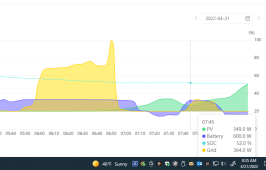SolarHead
50% of people are below average. (Its a statistic)
I'm wondering how most people are timing their battery charging. Do you have your system set to start charging the batteries the moment the sun comes up? Or do you hold off and let the first sun of the day power your morning loads, then when the sun is up say 11am to 3pm, have your battery bank charging go during those times since I'm thinking you'd have enough PV to cover both your loads and your charging. Of course I am assuming you can top off your battery bank in 3-4 hours of the middle of the day. Maybe some people charge all day sun up to sun down, just to be able to top off a large battery bank. I have a small battery bank and I'm thinking for the time being have my charging occur towards the middle of the day and let the morning sun power my loads (and not my battery bank). However, I have ordered some more batteries and when they come in I don't know what I will want/need to do yet but , I may have to start charging first light just to be able to top the bank off by 6pm each day. I know our consumption through the night so really I should only be topping off the batteries from what we used during the night. So, should be able to top them off in less than 4 hours. I still am thinking I will power my loads in the mornings, and have my inverter set to charge batteries later in the day when I have quite a bit more PV coming in. I have a Sol-Ark and so far I haven't been able to figure out how to configure it to hold off on starting charging batteries till later in the day. It seems to send charging power to the batteries first thing in the morning which I don't like. I wish it would hold off till later in the day when I have more PV. I'm still working on it so hope to figure something out. Was just wondering if I'm worry about something that I dont need to worry about. Maybe its best to start charging the batteries at first light, I don't know. That's why I was asking what do most of you do, or recommend? and why.




